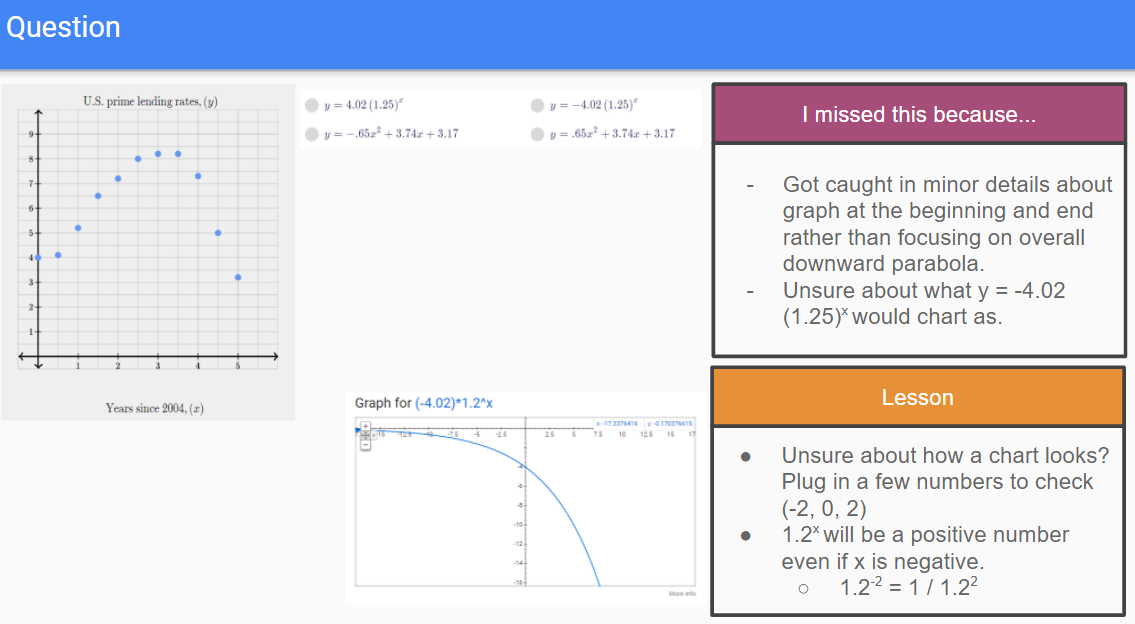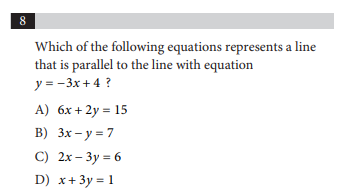SAT Math: Top 10 Study Tips
Below are a list of items that come up over and over when I’m tutoring / teaching students for the SAT Math test.
Tip 1: Document a ‘living study plan’
Far too often, students jump into studying without a plan. They’ll gather books and just start reading. Studying without a plan is a huge waste of time and often why students don’t feel prepared despite. Random, haphazard studying, even if it’s consistent, means students usually spend far too long preparing and don’t cover all the necessary materials.
As an SAT tutor, the first thing I do when I meet with students is go over the basics of the exam. Then I share a study plan document. This is not a set-in-stone document. It gets adjusted regularly based on the needs of the student. However, there’s always a plan. I start with a high-level plan and then we go down to a specific category plan (e.g., quadratic equation, complex numbers, etc).
Whether you work with a tutor or on your own, make sure you have a plan. You’ll be organized and your prep will go a lot smoother.
Below are examples of a high-level and detailed study plan for a current student. Keep in mind this document has been adjusted many times and we’re still adjusting it with 7 weeks to go before his exam.
Tip 2: Practice Questions, Questions, Questions
Set Khan Academy as a a bookmark on your browser. Research on exam prep has shown over and over again that practicing questions is critical to success. As you review questions, it is also critical to review the explanations. Yes, reviewing explanations may slow down the pace of the questions but it’s much more important to focus on quality. Use your time to understand what you missed, why you missed it, or if there may be a better approach even if you got it correct.
As a tutor, I have a teacher account and review every problem my students practice. I screenshot the ones they miss and cover them in our meet ups.
Tip 3: Track your errors and work on weaknesses
This is critical but, admittedly, challenging without a tutor. You have a few months to work to prep for the exam. How do you cover everything, practice all the questions you need to, and track your areas of weakness? After all, you need to keep moving forward and covering new areas continuously. It’s not enough to practice questions over and over - you need to cover the areas where you struggle.
If you’re studying on your own, document what you miss, and incorporating reviewing those concepts / questions in your study plan.
For students I tutor, I will track every question they miss and make sure we cover them multiple times. Below is an example of a template I use for questions my students miss during their question practice time.
Tip 4: Draw, Underline, Markup your paper
Give me two completed SAT math tests to compare. If one of the tests is highly marked up and the other one has few markups, the student that has marked up the test will score higher. This isn’t universally but is true in 90%+ of the students I have every taught. I have only ever had one student who was a high scorer without marking up his test.
Underlining what his being asked, marking up questions, and drawing charts all help in understanding the question and limiting silly mistakes. Couple examples:
Mark up what you’re being asked: You should always underline what is being asked in the questions. I can’t begin to explain how often I see students solve for X when they’re being asked for Y. It’s a silly mistake but one that the College Board knows you’re likely to make. Hence, you’ll see the correct answer for X in one of the answer choices. The test is as much about following instructions as it is about understanding concepts.
Draw charts, geometric figures: Many questions will ask you about a chart or geometric figure but not provide an image for you. Points within the question are difficult to organize in your mind if you’re not able to visualize them.
Tip 5: Use a good book, not 15 good books
This is part of having a plan. Students always wonder how many books they should use. The answer is one. Find a really good book that explains all the concepts and has a bunch of examples and practice problems. And then use it as a reference guide. There is no need to go through a whole bunch of books. For math, my favorite books on the market are The College Panda SAT Math and PWN The SAT Math Guide but there are definitely others that are really good as well.
A prospective student emailed me recently asking me for book recommendations. Her email is representative of what a lot of students think they need to do.
Tip 6: Used Spaced Repetition
Spaced repetition is the idea that you put gaps between repeating what you need to learn.
To simplify it, let’s say you want to memorize the capital of Morocco is Rabat. If you are learning this for the first time today, science tells us that you will forget it after 24 hours if you never see or repeat this again. Alternatively, if you repeat it within 24 hours, you’ll remember it for a longer period of time (perhaps 3 days). If, after a couple more days, you repeat this again, you’ll remember it for perhaps a week. And so on and so forth. Of course, the numbers aren’t exact (24 hours, 3 days, one week) but the idea is that if you spaced out your repetition, you’ll retain it for long periods of time.
Unfortunately, how students often learn is to repeat the same thing over and over 10 times in a single sitting expecting that they will retain it. Science tells us that they’ll still forget it within 24 hours.
For students I tutor, I keep a log on what they need to repeat, and a schedule of when I want to repeat those questions. This is why I am so keen on TutorTime+. You need spaced repetition for retention and you need retention for mastery.
Tip 7: Use Mnemonics, Visualization to memorize important information
Most students can recall the mnemonic PEMDAS (Power, Exponents, Multiply, Divide, Add, Subtract) for order of operations.
There are others that can be helpful for SAT Math such as FOIL, MADSPM and SOHCAHTOA.
In addition, use visualization memory techniques to remember other quick facts and formulas.
One example is figuring out the slope when you’re given a line in the standard Form Ax + By = C. Most students will convert this into the slope-intercept form (y = mx + b) and figure what m is. That’s alright to do though you may save some time if you know the slope out of the standard form. My trick for remembering this is to use a memory trick recommended by some of the ‘memorizers’ in the world: Create a visualization.
The formula for slope in the standard form is -A/B. How do I remember this? I visualize a ski slope where an Apple is on top of a Basketball. Negative represents downhill, and A = Apple, B = Basketball. Is this silly? Yes. Does it work? yes.
Think this is unnecessary to learn? Again, you can always convert to the slope-intercept form but look at an old exam problem below to see how it may be a useful, time sloping visualization
Students quickly figure out that the slope to the equation is -3 because it’s in slope-intercept form. But now how do you figure out the slope to all the answer choices? Do you need to convert them all into slope-intercept form? Not if you know that in the standard form the slope is -A/B.
Example:
2x + 3y = 15. What is the slope?
-A/B = -2/3
Tip 8: Slow Down.
Most kids I teach have no problem with finishing the math section. They understand the concepts, know the tricks, and are able to finish with plenty of time remaining. But when I give them practice exams, they, far too often, make silly mistakes that they shouldn’t. The ones that finish first often make the most silly mistakes. Why? They don’t check their work.
How do you check your work? Whenever you can, check your work by plugging in the answer choices. Yes, double check your work. Sometimes, it’s critical (in the case of extraneous solutions). Other times, you may find that you’ve made a silly mistake. I just finished reviewing a practice exam for a student who would have gotten a perfect 800 on the SAT Math if he hadn’t rounded the very last question to the hundredths (the question asked students to round to the tenth).
If you have a solid understanding of the concepts and have practiced enough problems, time will almost certainly not be an issue on the exam. Note that there are no bonus points for being the first to finish.
Tip 9: Know what’s on Page 1
You don’t need to memorize the formulas on page 1. Of course, if you knew them well, you may save a few seconds but it’s not necessary. But you do need to know what’s there and how you will use them and when you need them.
For example, with my students, I don’t push them to memorize the volume formulas. However, I give them a lot of special right triangle problems that they generally have the measures of the sides memorized. More importantly, they know how to use each one of the facts on the exam. Note, especially with special right triangles, it’s not enough to just know the measures are on the first page. It’s a topic that shows up often on the exam and one that needs a fair amount of practice.
Tip 10: Leverage the rules of the test
These are some of the many rules of the game you need to know:
You have 25 minutes for Section 3 (No Calculator) and 55 minutes for Section 4 (Calculator)
Each question is worth the same: Don’t spend too much time on some to the detriment of others. They’re all worth the same.
There are no negative points for getting something wrong. That means that you should never leave any question blank. It doesn’t hurt to guess.
Easiest questions for SAT Math come first. The test gets progressively harder.
No leading zeros in the grid-in: On the grid-in section, don’t write in leading zeros. Example: If the answer is 1/2, then .5 would be correct while .5 would not be correct.
When you’re studying, be aware of how much of each section shows up on the exam. Heart of Algebra is the biggest section, followed by Data Analysis, Passport to Advanced Math and, finally, Additional Topics. If you’re looking for a really high score, you’ll want to study hard for each section but it’s still important to know what’s worth more than others.











